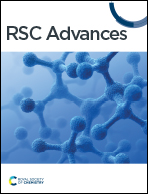Non-doped and transition metal-doped CuO nano-powders: structure-physical properties and anti-adhesion activity relationship
Abstract
Bacterial contamination and biofilm formation generate severe problems in many fields. Among these biofilm-forming bacteria, Staphylococcus epidermidis (S. epidermidis) has emerged as a major cause of nosocomial infection (NI). However, with the dramatic rise in resistance toward conventional antibiotics, there is a pressing need for developing effective anti-biofilms. So, fabrication of copper oxide nanoparticles (NPs) is one of the new strategies to combat biofilms. Notably, doped CuO NPs in anti-biofilm therapy have become a hot spot of attention in recent years due to their physicochemical properties. In this context, the present work deals with the investigation of undoped and transition metal (TM)-doped CuO NPs (TM = Zn, Ni, Mn, Fe and Co), synthesized via the co-precipitation method. The synthesized CuO NPs are characterized using X-ray diffraction (XRD), Fourier transform infrared (FTIR) spectroscopy, field-emission scanning electron microscopy (FE-SEM), energy dispersive spectroscopy (EDS) and X-ray photoelectron spectroscopy (XPS). Results consistently revealed the successful formation of CuO NPs using the co-precipitation method and confirmed that TM ions are successfully inserted into CuO crystal lattice. We found that doping changes the morphology of the CuO NPs and increases their crystallite size. The XPS results show a non-uniform distribution of the doping concentration, with a depletion or an enrichment of the NP surface depending on the element considered. Furthermore, the anti-adhesive potential of CuO NPs against S. epidermidis S61 biofilm formation is evaluated in this study by crystal violet and fluorescence microscopy assays. All synthesized NPs exhibit considerable anti-adhesive activity against S. epidermidis S61 biofilm. Interestingly, compared to undoped CuO, Fe and Ni-doped oxides show an improved activity when used at high concentrations, whereas Mn-doped CuO is the most efficient at low concentrations. This makes TM-doped CuO a promising candidate to be used in biomedical applications.



 Please wait while we load your content...
Please wait while we load your content...